Analysis of Crop Sustainability Production Potential in Northwest China: Water Resources Perspective
Abstract
1. Introduction
2. Materials and Methods
2.1. Overview of the Study Area
2.2. Methods
2.2.1. Water Footprint of Crop Production
2.2.2. Water-Resource Load Index
2.3. Data Sources
3. Results
3.1. Potential Analysis of Agricultural Available Water Resources
3.2. Evolutionary Characteristics of Agricultural Available Water Resources
3.3. Demand Characteristics of Water Resources for Crop Production
3.3.1. Characteristics of Water Footprint of Crop Production
3.3.2. Evolutionary Characteristics of Crop Water Footprint
4. Discussion
5. Conclusions
Funding
Institutional Review Board Statement
Data Availability Statement
Conflicts of Interest
References
- Ali, N.; Mujeeb-Kazi, A. Food Production: Global Challenges to Mitigate Climate Change. In Physiological, Molecular, and Genetic Perspectives of Wheat Improvement; Springer: Cham, Switzerland, 2021; pp. 1–13. [Google Scholar]
- Agus, C.; Nugraheni, M.; Wuri, M.A.; Pertiwiningrum, A.; Hasanah, N.A.I.; Sugiyanto, C.; Nurjanto, H.H.; Primananda, E. The Challenges of Food Sovereignty’s Program by Global Climate Change in Tropical Ecosystem in Indonesia. In Handbook of Climate Change Across the Food Supply Chain; Springer: Berlin/Heidelberg, Germany, 2022; pp. 267–283. [Google Scholar]
- Mottaleb, K.A.; Fatah, F.A.; Kruseman, G.; Erenstein, O. Projecting food demand in 2030: Can Uganda attain the zero hunger goal? Sustain. Prod. Consum. 2021, 28, 1140–1163. [Google Scholar] [CrossRef]
- Unicef; World Health Organization. The State of Food Security and Nutrition in the World 2017: Building Resilience for Peace and Food Security; Food and Agriculture Organization of the United Nations: Rome, Italy, 2017. [Google Scholar]
- Szenkovics, D.; Tonk, M.; Balog, A. Can genetically modified (GM) crops act as possible alternatives to mitigate world political conflicts for food? Food Energy Secur. 2021, 10, e268. [Google Scholar] [CrossRef]
- Harpankar, K. Optimal Nitrogen Management for Meeting Sustainable Development Goal 2. In Science, Technology, and Innovation for Sustainable Development Goals: Insights from Agriculture, Health, Environment, and Energy; Oxford University Press: Oxford, UK, 2020; 367p. [Google Scholar]
- Garai, T.; Garg, H. Possibilistic multiattribute decision making for water resource management problem under single-valued bipolar neutrosophic environment. Int. J. Intell. Syst. 2022, 37, 5031–5058. [Google Scholar] [CrossRef]
- Garai, T.; Garg, H. Multi-criteria decision making of water resource management problem (in agriculture field, Purulia district) based on possibility measures under generalized single valued non-linear bipolar neutrosophic environment. Expert Syst. Appl. 2022, 205, 117715. [Google Scholar] [CrossRef]
- Dubey, P.K.; Singh, A.; Chaurasia, R.; Pandey, K.K.; Bundela, A.K.; Dubey, R.K.; Abhilash, P.C. Planet friendly agriculture: Farming for people and the planet. Curr. Res. Environ. Sustain. 2021, 3, 100041. [Google Scholar] [CrossRef]
- Prăvălie, R.; Bandoc, G.; Patriche, C.; Sternberg, T. Recent changes in global drylands: Evidences from two major aridity databases. Catena 2019, 178, 209–231. [Google Scholar] [CrossRef]
- Banholzer, S.; Kossin, J.; Donner, S. The impact of climate change on natural disasters. In Reducing Disaster: Early Warning Systems for Climate Change; Springer: Dordrecht, The Netherlands, 2014; pp. 21–49. [Google Scholar]
- Kang, S.; Hao, X.; Du, T.; Tong, L.; Su, X.; Lu, H.; Li, X.; Huo, Z.; Li, S.; Ding, R. Improving agricultural water productivity to ensure food security in China under changing environment: From research to practice. Agric. Water Manag. 2017, 179, 5–17. [Google Scholar] [CrossRef]
- Ringler, C.; Zhu, T. Water resources and food security. Agron. J. 2015, 107, 1533–1538. [Google Scholar] [CrossRef]
- Chen, X.; Yang, S.-H.; Jiang, Z.-W.; Ding, J.; Sun, X. Biochar as a tool to reduce environmental impacts of nitrogen loss in water-saving irrigation paddy field. J. Clean. Prod. 2021, 290, 125811. [Google Scholar] [CrossRef]
- Umair, M.; Hussain, T.; Jiang, H.; Ahmad, A.; Yao, J.; Qi, Y.; Zhang, Y.; Min, L.; Shen, Y. Water-saving potential of subsurface drip irrigation for winter wheat. Sustainability 2019, 11, 2978. [Google Scholar] [CrossRef]
- Zapata, N.; Robles, O.; Playán, E.; Paniagua, P.; Romano, C.; Salvador, R.; Montoya, F. Low-pressure sprinkler irrigation in maize: Differences in water distribution above and below the crop canopy. Agric. Water Manag. 2018, 203, 353–365. [Google Scholar] [CrossRef]
- Xiao, M.; Li, Y.; Wang, J.; Hu, X.; Wang, L.; Miao, Z. Study on the law of nitrogen transfer and conversion and use of fertilizer nitrogen in paddy fields under water-saving irrigation mode. Water 2019, 11, 218. [Google Scholar] [CrossRef]
- He, H.; Wang, Q.; Wang, L.; Yang, K.; Yang, R.; You, C.; Ke, J.; Wu, L. Photosynthetic physiological response of water-saving and drought-resistant rice to severe drought under wetting-drying alternation irrigation. Physiol. Plant. 2021, 173, 2191–2206. [Google Scholar] [CrossRef]
- Valcárcel, M.; Lahoz, I.; Campillo, C.; Martí, R.; Leiva-Brondo, M.; Rosello, S.; Cebolla-Cornejo, J. Controlled deficit irrigation as a water-saving strategy for processing tomato. Sci. Hortic. 2020, 261, 108972. [Google Scholar] [CrossRef]
- Chen, X.; Yang, S.; Ding, J.; Jiang, Z.; Sun, X. Effects of biochar addition on rice growth and yield under water-saving irrigation. Water 2021, 13, 209. [Google Scholar] [CrossRef]
- Ambika, A.K.; Mishra, V. Improved water savings and reduction in moist heat stress caused by efficient irrigation. Earth’s Future 2022, 10, e2021EF002642. [Google Scholar] [CrossRef]
- Washizu, A.; Nakano, S. Exploring the characteristics of smart agricultural development in Japan: Analysis using a smart agricultural kaizen level technology map. Comput. Electron. Agric. 2022, 198, 107001. [Google Scholar] [CrossRef]
- Moysiadis, V.; Sarigiannidis, P.; Vitsas, V.; Khelifi, A. Smart farming in Europe. Comput. Sci. Rev. 2021, 39, 100345. [Google Scholar] [CrossRef]
- Liu, X.; Xu, Y.; Sun, S.; Zhao, X.; Wang, Y. Analysis of the Coupling Characteristics of Water Resources and Food Security: The Case of Northwest China. Agriculture 2022, 12, 1114. [Google Scholar] [CrossRef]
- Liu, X.; Shi, L.; Engel, B.A.; Sun, S.; Zhao, X.; Wu, P.; Wang, Y. New challenges of food security in Northwest China: Water footprint and virtual water perspective. J. Clean. Prod. 2020, 245, 118939. [Google Scholar] [CrossRef]
- Lu, S.; Hu, Z.; Yu, H.; Fan, W.; Fu, C.; Wu, D. Changes of extreme precipitation and its associated mechanisms in Northwest China. Adv. Atmos. Sci. 2021, 38, 1665–1681. [Google Scholar] [CrossRef]
- Wei, K.; Wang, L. Reexamination of the aridity conditions in arid Northwestern China for the last decade. J. Clim. 2013, 26, 9594–9602. [Google Scholar] [CrossRef]
- Yang, Y.; Feng, Z.; Huang, H.Q.; Lin, Y. Climate-induced changes in crop water balance during 1960–2001 in Northwest China. Agric. Ecosyst. Environ. 2008, 127, 107–118. [Google Scholar] [CrossRef]
- Sun, S.K.; Wu, P.T.; Wang, Y.B.; Zhao, X.N. Temporal Variability of Water Footprint for Maize Production: The Case of Beijing from 1978 to 2008. Water Resour. Manag. 2013, 27, 2447–2463. [Google Scholar] [CrossRef]
- Hoekstra, A.Y.; Mekonnen, M.M. The water footprint of humanity. Proc. Natl. Acad. Sci. USA 2012, 109, 3232–3237. [Google Scholar] [CrossRef]
- Siebert, S.; Döll, P.; Hoff, H.; Falkenmark, M.; Gerten, D.; Gordon, L.; Karlberg, L.; Rockström, J. Quantifying blue and green virtual water contents in global crop production as well as potential production losses without irrigation. J. Hydrol. 2010, 384, 198–217. [Google Scholar] [CrossRef]
- Hoekstra, A.Y.; Chapagain, A.K.; Aldaya, M.M.; Mekonnen, M.M. The Water Footprint Assessment Manual: Setting the Global Standard; Routledge: London, UK, 2011. [Google Scholar]
- Sun, S.; Wu, P.; Wang, Y.; Zhao, X.; Liu, J.; Zhang, X. The impacts of interannual climate variability and agricultural inputs on water footprint of crop production in an irrigation district of China. Sci. Total Environ. 2013, 444, 498–507. [Google Scholar] [CrossRef]
- Luan, X.; Wu, P.; Sun, S.; Wang, Y.; Gao, X. Quantitative study of the crop production water footprint using the SWAT model. Ecol. Indic. 2018, 89, 1–10. [Google Scholar] [CrossRef]
- Allen, R.G.; Pereira, L.S.; Raes, D.; Smith, M. Crop Evapotranspiration-Guidelines for Computing Crop Water Requirements; FAO Irrigation and Drainage Paper 56; FAO: Rome, Italy, 1998; Volume 300, p. D05109. [Google Scholar]
- Sun, S.; Zhang, C.; Li, X.; Zhou, T.; Wang, Y.; Wu, P.; Cai, H. Sensitivity of crop water productivity to the variation of agricultural and climatic factors: A study of Hetao irrigation district, China. J. Clean. Prod. 2017, 142, 2562–2569. [Google Scholar] [CrossRef]
- Döll, P.; Siebert, S. Global modeling of irrigation water requirements. Water Resour. Res. 2002, 38, 1–10. [Google Scholar] [CrossRef]
- Sun, S.; Yin, Y.; Wu, P.; Wang, Y.; Luan, X.; Li, C. Geographical evolution of agricultural production in China and its effects on water stress, economy, and the environment: The virtual water perspective. Water Resour. Res. 2019, 55, 4014–4029. [Google Scholar] [CrossRef]
- Xia, F.; Chen, Y.; Dou, M.; Han, Y. Calculation method and application of spatial equilibrium coefficient of water resources. Water Resour. Prot. 2020, 36, 52–57. [Google Scholar]
- Pricey crops. Nat. Plants 2021, 7, 993. [CrossRef] [PubMed]
- Baig, M.B.; Shahid, S.A.; Straquadine, G.S. Making rainfed agriculture sustainable through environmental friendly technologies in Pakistan: A review. Int. Soil Water Conserv. Res. 2013, 1, 36–52. [Google Scholar] [CrossRef]
- Dogliotti, S.; García, M.C.; Peluffo, S.; Dieste, J.P.; Pedemonte, A.J.; Bacigalupe, G.F.; Scarlato, M.; Alliaume, F.; Alvarez, J.; Chiappe, M. Co-innovation of family farm systems: A systems approach to sustainable agriculture. Agric. Syst. 2014, 126, 76–86. [Google Scholar] [CrossRef]
- Gerten, D.; Heck, V.; Jägermeyr, J.; Bodirsky, B.L.; Fetzer, I.; Jalava, M.; Kummu, M.; Lucht, W.; Rockström, J.; Schaphoff, S. Feeding ten billion people is possible within four terrestrial planetary boundaries. Nat. Sustain. 2020, 3, 200–208. [Google Scholar] [CrossRef]
- Ahmed, F.E.; Hashaikeh, R.; Hilal, N. Hybrid technologies: The future of energy efficient desalination—A review. Desalination 2020, 495, 114659. [Google Scholar] [CrossRef]
- Gao, L.; Zhang, X.; Fan, L.; Gray, S.; Li, M. Algae-based approach for desalination: An emerging energy-passive and environmentally friendly desalination technology. ACS Sustain. Chem. Eng. 2021, 9, 8663–8678. [Google Scholar] [CrossRef]
- Park, J.; Lee, S. Desalination technology in South Korea: A comprehensive review of technology trends and future outlook. Membranes 2022, 12, 204. [Google Scholar] [CrossRef]
- Chauhan, V.K.; Shukla, S.K.; Tirkey, J.V.; Rathore, P.K.S. A comprehensive review of direct solar desalination techniques and its advancements. J. Clean. Prod. 2021, 284, 124719. [Google Scholar] [CrossRef]
- Ahmed, F.E.; Khalil, A.; Hilal, N. Emerging desalination technologies: Current status, challenges and future trends. Desalination 2021, 517, 115183. [Google Scholar]
- Yang, J.; Chen, H.; Liu, Q.; Zhou, N.; Wu, Y. Is it feasible to replace freshwater by seawater in hydrothermal liquefaction of biomass for biocrude production? Fuel 2020, 282, 118870. [Google Scholar] [CrossRef]
- Zhuang, W. Eco-environmental impact of inter-basin water transfer projects: A review. Environ. Sci. Pollut. Res. 2016, 23, 12867–12879. [Google Scholar] [CrossRef] [PubMed]
- Duan, K.; Sun, G.; Caldwell, P.V.; McNulty, S.G.; Zhang, Y. Implications of upstream flow availability for watershed surface water supply across the conterminous United States. JAWRA J. Am. Water Resour. Assoc. 2018, 54, 694–707. [Google Scholar] [CrossRef]
- Dickson, K.E.; Dzombak, D.A. Drivers of interbasin transfers in the United States: Insights from sampling. JAWRA J. Am. Water Resour. Assoc. 2019, 55, 1038–1052. [Google Scholar] [CrossRef]
- Duan, K.; Caldwell, P.V.; Sun, G.; McNulty, S.G.; Qin, Y.; Chen, X.; Liu, N. Climate change challenges efficiency of inter-basin water transfers in alleviating water stress. Environ. Res. Lett. 2022, 17, 044050. [Google Scholar] [CrossRef]
- Zhang, C.; Duan, Q.; Yeh, P.J.F.; Pan, Y.; Gong, H.; Gong, W.; Di, Z.; Lei, X.; Liao, W.; Huang, Z. The effectiveness of the South-to-North Water Diversion Middle Route Project on water delivery and groundwater recovery in North China Plain. Water Resour. Res. 2020, 56, e2019WR026759. [Google Scholar]
- Opher, T.; Friedler, E.; Shapira, A. Comparative life cycle sustainability assessment of urban water reuse at various centralization scales. Int. J. Life Cycle Assess. 2019, 24, 1319–1332. [Google Scholar] [CrossRef]
- Klemeš, J.J. Industrial water recycle/reuse. Curr. Opin. Chem. Eng. 2012, 1, 238–245. [Google Scholar] [CrossRef]
- Hasan, H.H.; Razali, S.F.M.; Razali, N.H.M. Does the household Save water? evidence from behavioral analysis. Sustainability 2021, 13, 641. [Google Scholar] [CrossRef]
- Millock, K.; Nauges, C. Household adoption of water-efficient equipment: The role of socio-economic factors, environmental attitudes and policy. Environ. Resour. Econ. 2010, 46, 539–565. [Google Scholar] [CrossRef]
- Russell, S.; Fielding, K. Water demand management research: A psychological perspective. Water Resour. Res. 2010, 46, 1–12. [Google Scholar] [CrossRef]
- Kashem, S.; Mondal, M.S. Development of a Water-Pricing Model for Domestic Water Uses in Dhaka City Using an IWRM Framework. Water 2022, 14, 1328. [Google Scholar] [CrossRef]
- Paneysar, J.S.; Jain, S.; Ahmed, N.; Barton, S.; Ambre, P.; Coutinho, E. Novel smart composite materials for industrial wastewater treatment and reuse. SN Appl. Sci. 2020, 2, 1084. [Google Scholar] [CrossRef]
- Bauer, S.; Linke, H.J.; Wagner, M. Combining industrial and urban water-reuse concepts for increasing the water resources in water-scarce regions. Water Environ. Res. 2020, 92, 1027–1041. [Google Scholar] [CrossRef] [PubMed]
- Nzila, A.; Razzak, S.A.; Zhu, J. Bioaugmentation: An emerging strategy of industrial wastewater treatment for reuse and discharge. Int. J. Environ. Res. Public Health 2016, 13, 846. [Google Scholar] [CrossRef] [PubMed]
- Fudge, T.; Bulmer, I.; Bowman, K.; Pathmakanthan, S.; Gambier, W.; Dehouche, Z.; Al-Salem, S.M.; Constantinou, A. Microbial Electrolysis Cells for Decentralised Wastewater Treatment: The Next Steps. Water 2021, 13, 445. [Google Scholar] [CrossRef]
- Pamidimukkala, A.; Kermanshachi, S.; Adepu, N.; Safapour, E. Resilience in water infrastructures: A review of challenges and adoption strategies. Sustainability 2021, 13, 12986. [Google Scholar] [CrossRef]
- Mondal, S.; Rutkoski, J.E.; Velu, G.; Singh, P.K.; Crespo-Herrera, L.A.; Guzman, C.; Bhavani, S.; Lan, C.; He, X.; Singh, R.P. Harnessing diversity in wheat to enhance grain yield, climate resilience, disease and insect pest resistance and nutrition through conventional and modern breeding approaches. Front. Plant Sci. 2016, 7, 991. [Google Scholar] [CrossRef]
- Recha, J.W.; Mati, B.M.; Nyasimi, M.; Kimeli, P.K.; Kinyangi, J.M.; Radeny, M. Changing rainfall patterns and farmers’ adaptation through soil water management practices in semi-arid eastern Kenya. Arid Land Res. Manag. 2016, 30, 229–238. [Google Scholar] [CrossRef]
- Kumar, G.; Chander, H. Polylined water harvesting tank technique to mitigate the impact of climate change on agro-economy in rain fed conditions: A case study. J. Biol. Chem. Chron 2018, 4, 1–7. [Google Scholar]
- Badu-Apraku, B.; Fakorede, M.; Oyekunle, M.; Yallou, G.; Obeng-Antwi, K.; Haruna, A.; Usman, I.; Akinwale, R. Gains in grain yield of early maize cultivars developed during three breeding eras under multiple environments. Crop Sci. 2015, 55, 527–539. [Google Scholar] [CrossRef]
- Sengxua, P.; Samson, B.K.; Bounphanousay, C.; Xayavong, S.; Douangboupha, K.; Harnpichitvitaya, D.; Jackson, T.M.; Wade, L.J. Adaptation of rice (Oryza sativa L.) genotypes in the rainfed lowlands of Lao PDR. Plant Prod. Sci. 2017, 20, 477–484. [Google Scholar] [CrossRef]
- Cui, Y.; Li, R.; Li, G.; Zhang, F.; Zhu, T.; Zhang, Q.; Ali, J.; Li, Z.; Xu, S. Hybrid breeding of rice via genomic selection. Plant Biotechnol. J. 2020, 18, 57–67. [Google Scholar] [CrossRef]
- Chen, H.Q.; Liu, H.Y.; Wang, K.; Zhang, S.X.; Ye, X.G. Development and innovation of haploid induction technologies in plants. Yi Chuan Hered. 2020, 42, 466–482. [Google Scholar]
- Schaart, J.G.; van de Wiel, C.; Smulders, M.J. Genome editing of polyploid crops: Prospects, achievements and bottlenecks. Transgenic Res. 2021, 30, 337–351. [Google Scholar] [CrossRef]
- Karki, U.; Fang, H.; Guo, W.; Unnold-Cofre, C.; Xu, J. Cellular engineering of plant cells for improved therapeutic protein production. Plant Cell Rep. 2021, 40, 1087–1099. [Google Scholar] [CrossRef] [PubMed]
- Viana, V.E.; Pegoraro, C.; Busanello, C.; Costa de Oliveira, A. Mutagenesis in rice: The basis for breeding a new super plant. Front. Plant Sci. 2019, 10, 1326. [Google Scholar] [CrossRef] [PubMed]
- Rahman, S.U.; McCoy, E.; Raza, G.; Ali, Z.; Mansoor, S.; Amin, I. Improvement of Soybean; A Way Forward Transition from Genetic Engineering to New Plant Breeding Technologies. Mol. Biotechnol. 2022, 1–19. [Google Scholar] [CrossRef] [PubMed]
- Yang, J.; He, Y.; Luo, S.; Ma, X.; Li, Z.; Lin, Z.; Zhang, Z. Optimizing the Optimal Planting Period for Potato Based on Different Water-Temperature Year Types in the Agro-Pastoral Ecotone of North China. Agriculture 2021, 11, 1061. [Google Scholar] [CrossRef]
- Casadebaig, P.; Gauffreteau, A.; Landré, A.; Langlade, N.B.; Mestries, E.; Sarron, J.; Trépos, R.; Vincourt, P.; Debaeke, P. Optimized cultivar deployment improves the efficiency and stability of sunflower crop production at national scale. Theor. Appl. Genet. 2022, 1–15. [Google Scholar] [CrossRef] [PubMed]
- Dedeoğlu, M.; Dengiz, O. Generating of land suitability index for wheat with hybrid system aproach using AHP and GIS. Comput. Electron. Agric. 2019, 167, 105062. [Google Scholar] [CrossRef]
- Raza, M.A.; Cui, L.; Khan, I.; Din, A.M.U.; Chen, G.; Ansar, M.; Ahmed, M.; Ahmad, S.; Manaf, A.; Titriku, J.K. Compact maize canopy improves radiation use efficiency and grain yield of maize/soybean relay intercropping system. Environ. Sci. Pollut. Res. 2021, 28, 41135–41148. [Google Scholar] [CrossRef]
- Weih, M.; Karley, A.J.; Newton, A.C.; Kiær, L.P.; Scherber, C.; Rubiales, D.; Adam, E.; Ajal, J.; Brandmeier, J.; Pappagallo, S. Grain yield stability of cereal-legume intercrops is greater than sole crops in more productive conditions. Agriculture 2021, 11, 255. [Google Scholar] [CrossRef]
- Wu, Y.; Gong, W.; Yang, F.; Wang, X.; Yong, T.; Liu, J.; Pu, T.; Yan, Y.; Yang, W. Dynamic of recovery growth of intercropped soybean after maize harvest in maize–soybean relay strip intercropping system. Food Energy Secur. 2022, 11, e350. [Google Scholar] [CrossRef]
- Chen, P.; Song, C.; Liu, X.-M.; Zhou, L.; Yang, H.; Zhang, X.; Zhou, Y.; Du, Q.; Pang, T.; Fu, Z.-D. Yield advantage and nitrogen fate in an additive maize-soybean relay intercropping system. Sci. Total Environ. 2019, 657, 987–999. [Google Scholar] [CrossRef]
- Fang, Y.; Ren, T.; Zhang, S.; Liu, Y.; Liao, S.; Li, X.; Cong, R.; Lu, J. Rotation with oilseed rape as the winter crop enhances rice yield and improves soil indigenous nutrient supply. Soil Tillage Res. 2021, 212, 105065. [Google Scholar] [CrossRef]
- Song, X.; Huang, L.; Li, Y.; Zhao, C.; Tao, B.; Zhang, W. Characteristics of Soil Fungal Communities in Soybean Rotations. Front. Plant Sci. 2022, 13, 926731. [Google Scholar] [CrossRef] [PubMed]
- Abd Rahaman, M.S.; Cheng, L.-H.; Xu, X.-H.; Zhang, L.; Chen, H.-L. A review of carbon dioxide capture and utilization by membrane integrated microalgal cultivation processes. Renew. Sustain. Energy Rev. 2011, 15, 4002–4012. [Google Scholar] [CrossRef]
- Verhage, L. Model behavior: Finding out how to increase photosynthesis in C4 crops. Plant J. 2021, 107, 341–342. [Google Scholar] [CrossRef]
- Li, Y.; Ding, Y.; Li, D.; Miao, Z. Automatic carbon dioxide enrichment strategies in the greenhouse: A review. Biosyst. Eng. 2018, 171, 101–119. [Google Scholar] [CrossRef]
- Yu, X.; Zhang, Q.; Gao, J.; Wang, Z.; Borjigin, Q.; Hu, S.; Zhang, B.; Ma, D. Planting density tolerance of high-yielding maize and the mechanisms underlying yield improvement with subsoiling and increased planting density. Agronomy 2019, 9, 370. [Google Scholar] [CrossRef]
- Dembele, J.S.B.; Gano, B.; Kouressy, M.; Dembele, L.L.; Doumbia, M.; Ganyo, K.K.; Sanogo, S.; Togola, A.; Traore, K.; Vaksman, M. Plant density and nitrogen fertilization optimization on sorghum grain yield in Mali. Agron. J. 2021, 113, 4705–4720. [Google Scholar] [CrossRef]
- Bei, G.; Zhang, S.; Guo, Y.; Yanli, L.; Hu, N.; Liu, J. Study on Meteorological Disaster Monitoring of Field Fruit Industry by Remote Sensing Data. Adv. Meteorol. 2022, 2022, 1659053. [Google Scholar] [CrossRef]
- Abraha, T.; Basir, F.A.; Obsu, L.L.; Torres, D.F. Farming awareness based optimum interventions for crop pest control. arXiv 2021, arXiv:2106.08192. [Google Scholar] [CrossRef]
- Muneret, L.; Mitchell, M.; Seufert, V.; Aviron, S.; Djoudi, E.A.; Pétillon, J.; Plantegenest, M.; Thiéry, D.; Rusch, A. Evidence that organic farming promotes pest control. Nat. Sustain. 2018, 1, 361–368. [Google Scholar] [CrossRef]
- Widiastuti, D.; Marzuki, S.; Hatta, M. Utilization of Organic Fertilizer in Response to Mitigate CO2 Emission; IOP Conference Series: Earth and Environmental Science; IOP Publishing Ltd.: Bristol, UK, 2021; Volume 648, p. 012120. [Google Scholar]
- Liu, X.; Shi, L.; Qian, H.; Sun, S.; Wu, P.; Zhao, X.; Engel, B.A.; Wang, Y. New problems of food security in northwest china: A sustainability perspective. Land Degrad. Dev. 2020, 31, 975–989. [Google Scholar] [CrossRef]
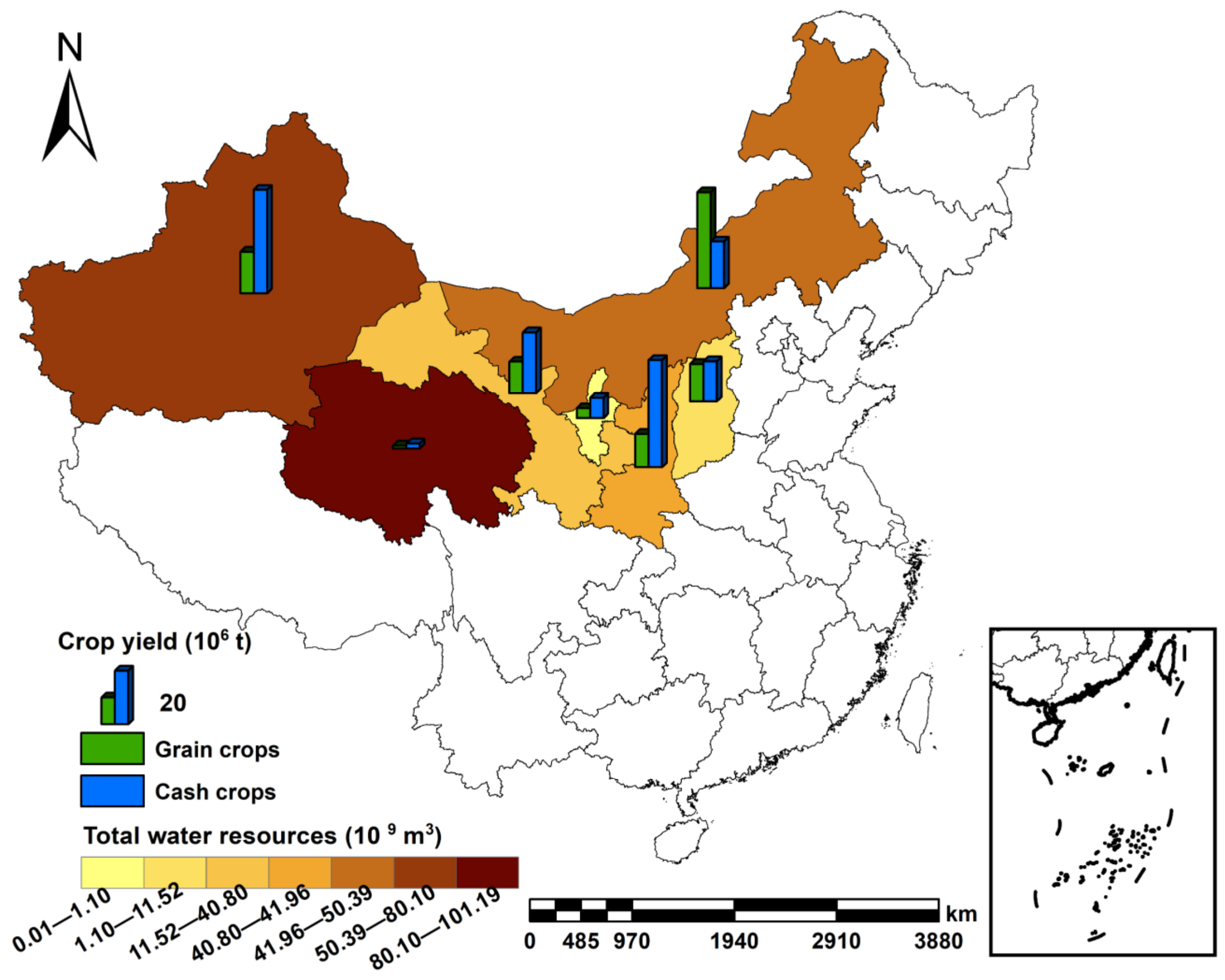
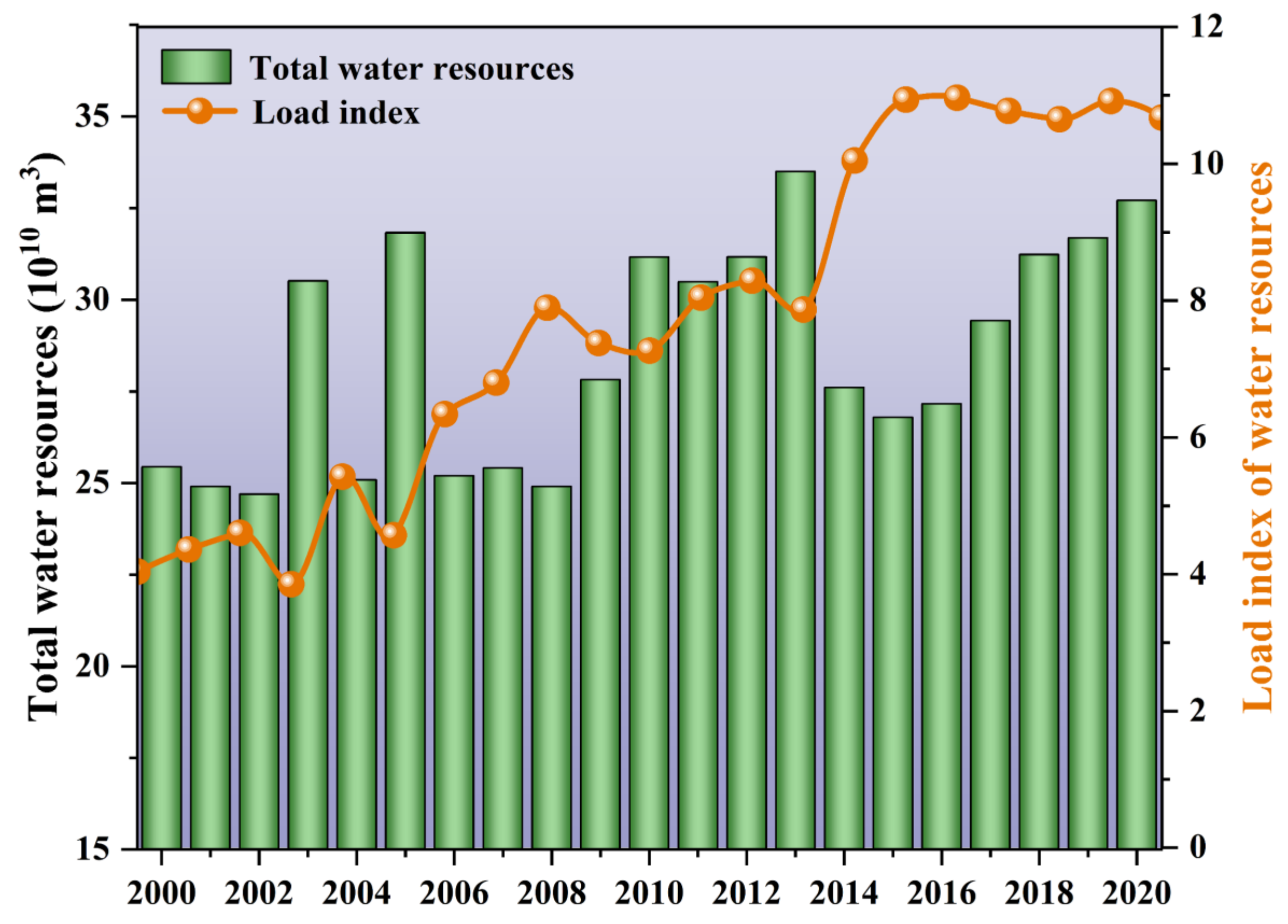
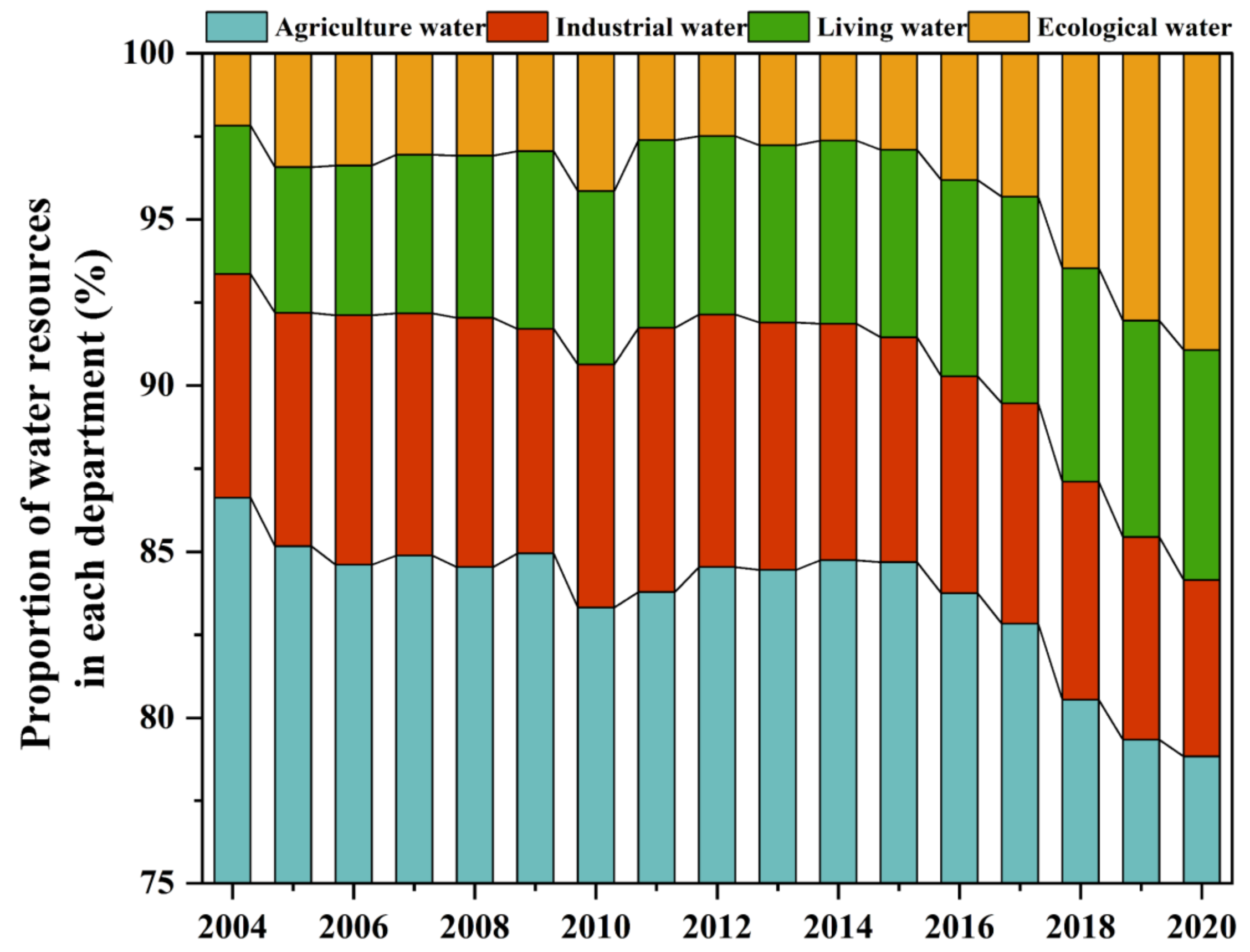
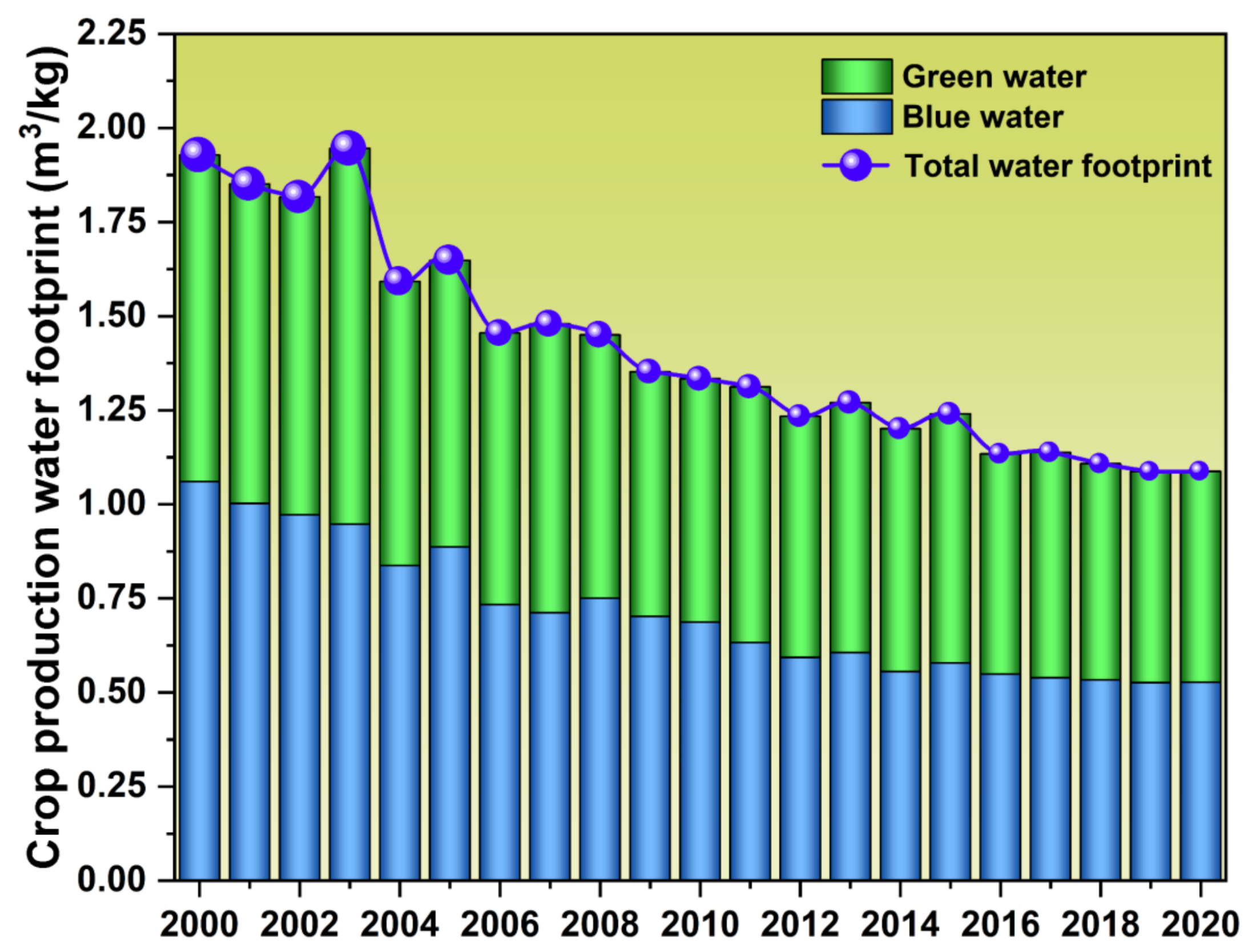

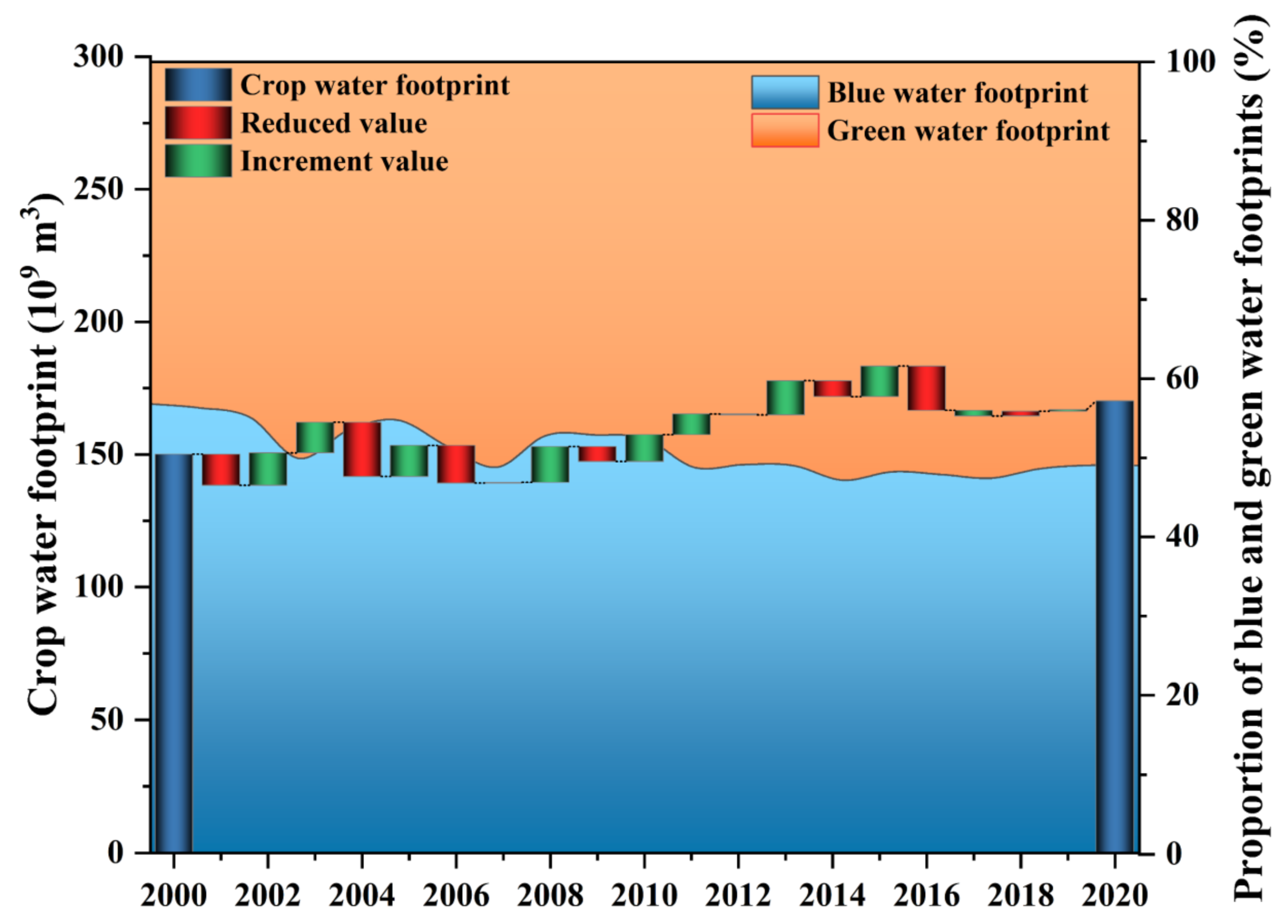

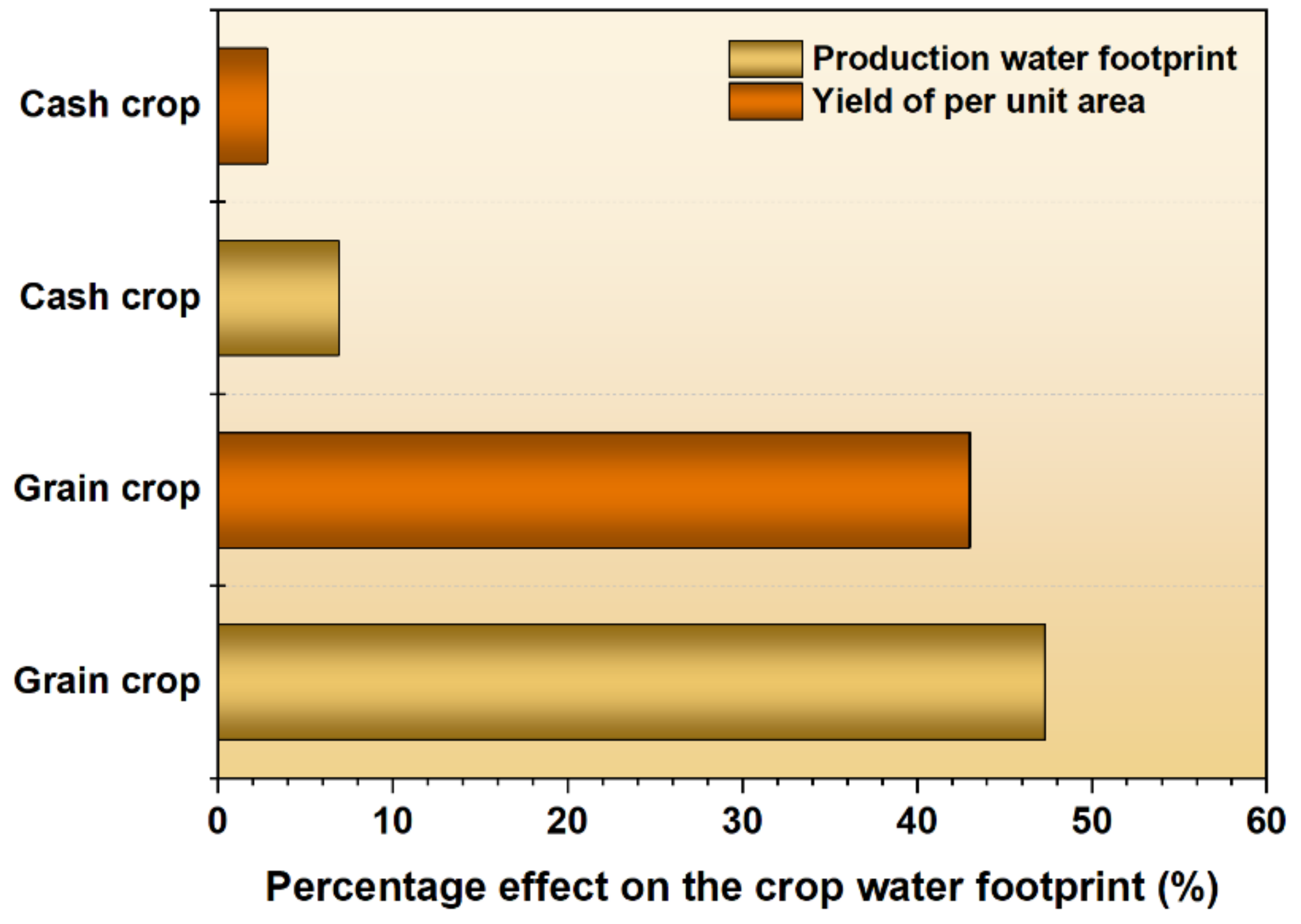
Publisher’s Note: MDPI stays neutral with regard to jurisdictional claims in published maps and institutional affiliations. |
© 2022 by the author. Licensee MDPI, Basel, Switzerland. This article is an open access article distributed under the terms and conditions of the Creative Commons Attribution (CC BY) license (https://creativecommons.org/licenses/by/4.0/).
Share and Cite
Liu, X. Analysis of Crop Sustainability Production Potential in Northwest China: Water Resources Perspective. Agriculture 2022, 12, 1665. https://doi.org/10.3390/agriculture12101665
Liu X. Analysis of Crop Sustainability Production Potential in Northwest China: Water Resources Perspective. Agriculture. 2022; 12(10):1665. https://doi.org/10.3390/agriculture12101665
Chicago/Turabian StyleLiu, Xian. 2022. "Analysis of Crop Sustainability Production Potential in Northwest China: Water Resources Perspective" Agriculture 12, no. 10: 1665. https://doi.org/10.3390/agriculture12101665
APA StyleLiu, X. (2022). Analysis of Crop Sustainability Production Potential in Northwest China: Water Resources Perspective. Agriculture, 12(10), 1665. https://doi.org/10.3390/agriculture12101665





